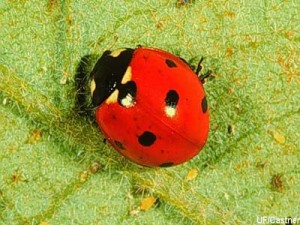Exotic Ladybeetle Found In Southern California
 Question from Lee:
Question from Lee:
Ladybugs, once the championed protectors of backyard gardens, are showing spots of a less flattering color, and their public image looks like it could be taking an even bigger turn for the worse. A new study has found that invasive Harlequin ladybugs crossbreeding with a species of flightless ladybugs are creating a super strain of a buggy pest.
In recent years, ladybugs have taken their voracious appetites around the world, and they don’t just gobble up target insects. Couple this with plagues of ladybugs infesting homes, and you’ve got an unseemly problem on your hands.
To fight their spread, flightless ladybugs were released as a biological control agent. The idea being that the walk-only ladybugs wouldn’t spread as far as quick. Harlequin’s aren’t to be put off it would seem. The two types of ladybugs can hybridize, giving rise to offspring that are larger, faster-growing, and generally more robust than either of its parent species. Preliminary research suggests that the cross-bred young are even better-equipped to deal with starvation.
The findings by BenoÎt Facon of UMR Centre de Biologie et de Gestion des Populations in Cedex, France, and his colleagues are just a beginning. Researchers want to test multiple generations of hybrid and subject them to different conditions to unravel the magnitude of the Harlequin ladybug dilemma.
You can read more about their discoveries in the current issue of Evolutionary Applications.
Answer from Pat:
According to the link you sent me, the beetle you photographed is a Multicolored Asian Ladybeetle (Harmonia axyridis), an exotic insect introduced into the United States in order to control pests. This insect may be one of the exotic species that is hybridizing with our native ladybugs. The photographs below are said to show some of these hybrids including one photo that appears similar though not exactly the same as the beetle you found in Del Mar. (Second row up, second from the left.)
I had heard of the Cornell study involving backyard biologists looking for lost ladybugs. They found a ladybug species that was thought to have disappeared from New York. But here is some less cheery news: It seems as if some of these exotic introduced ladybugs are hybridizing with our native ladybugs and morphing into new insects that may actually upset the balance of nature. Our native ladybugs are beneficial types that eat pests, especially aphids, but according to some studies I have read that these new insects are fast-spreading and voracious, though non-flying, and may also eat a larger range of insects than we want them to eat.
When I saw your ladybug photo yesterday I wondered about it because of its orange color and smudgy spots. I had heard of orange ladybugs used as beneficials in the Sacramento Valley, but was not sure what yours was. The ladybugs shown in the photos below are listed as Harlequin-ladybugs, not the beneficial ones we are familiar with but possibly harmful hybrids. (Their habits are being studied.) You were wise to report your find to the Lost Ladybug study. Thank you for doing that and thank you for sharing your photo with me and with my readers.


Here is a photo of an orange ladybug on a yellow flower. I took the photo in Del Mar, California. Thought you might like to see it. Also, have you heard of Cornell’s Lost Ladybug project?: http://lostladybug.org/contributors-images.php?id=1986
CAN YOU EMAIL me a copy of that photo of an orange spotted “ladybug” you found? If you can, I will run a question from an anonymous “Lee” (without mentioning that we met by the Koolaid plant) and an answer from me on my website: https://patwelsh.com/wpmu/ in order to warn other gardeners. I had heard of the Cornell study which involving backyard biologists looking for lost ladybugs. They found a ladybug species that was thought to have disappeared from New York. But here is some less cheery news: It seems as if the harlequin beetle is hybridizing with ladybugs and morphing into new and more dangerous pests. When I saw your ladybug photo yesterday I wondered about it because of orange color and smudgy spots reminded me of an immature stage of harlequin beetle. I thought it might be a Vidalia beetle—which would have been good since that is a beneficial insect — but it was not. Unfortunately your orange ladybug appears to be photographed below, second row up, second from the left. These ladybug look-alikes are all Harlequin-ladybugs, not the beneficial ladybugs we are familiar with but harmful hybrids.